Healthcare Advancements: Technology Improving Patient Care in Canada
VerifiedAdded on 2023/06/11
|8
|1724
|82
Report
AI Summary
This report examines the role of technology in improving healthcare within Canada, focusing on three key advancements: 3D printers, Fitbits, and warm donor organ perfusion systems. It discusses how 3D printers are used for surgical planning and creating medical devices, Fitbits for patient monitoring and promoting healthy lifestyles, and warm donor organ perfusion systems for extending the viability of donor organs for transplantation. The report argues that these technologies are indeed improving healthcare by enhancing surgical precision, enabling remote patient monitoring, and increasing the availability of organs for transplantation. It concludes by highlighting the importance of ongoing assessment and management of healthcare technologies to ensure their effective implementation and impact on patient outcomes in Canada.
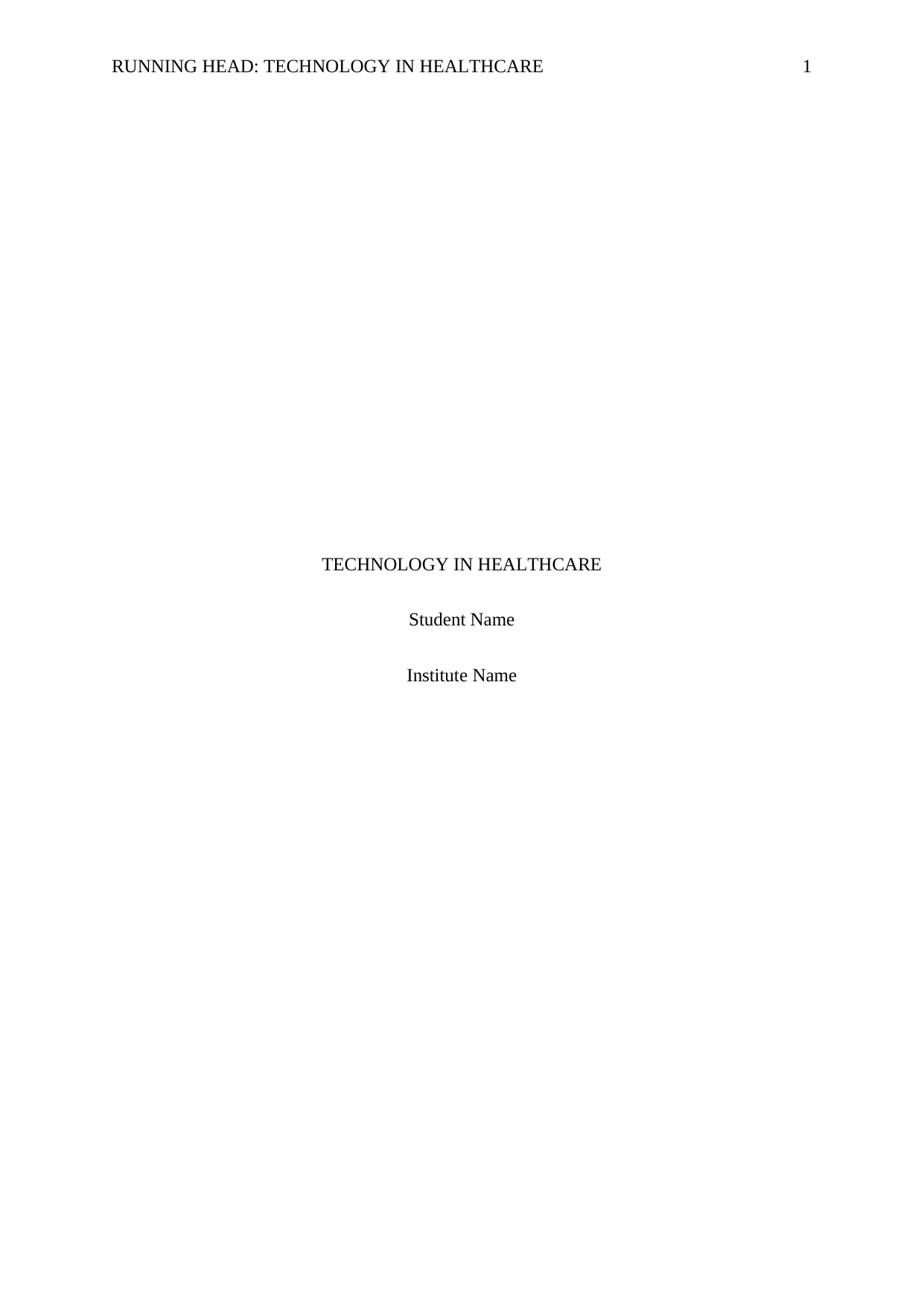
RUNNING HEAD: TECHNOLOGY IN HEALTHCARE 1
TECHNOLOGY IN HEALTHCARE
Student Name
Institute Name
TECHNOLOGY IN HEALTHCARE
Student Name
Institute Name
Paraphrase This Document
Need a fresh take? Get an instant paraphrase of this document with our AI Paraphraser
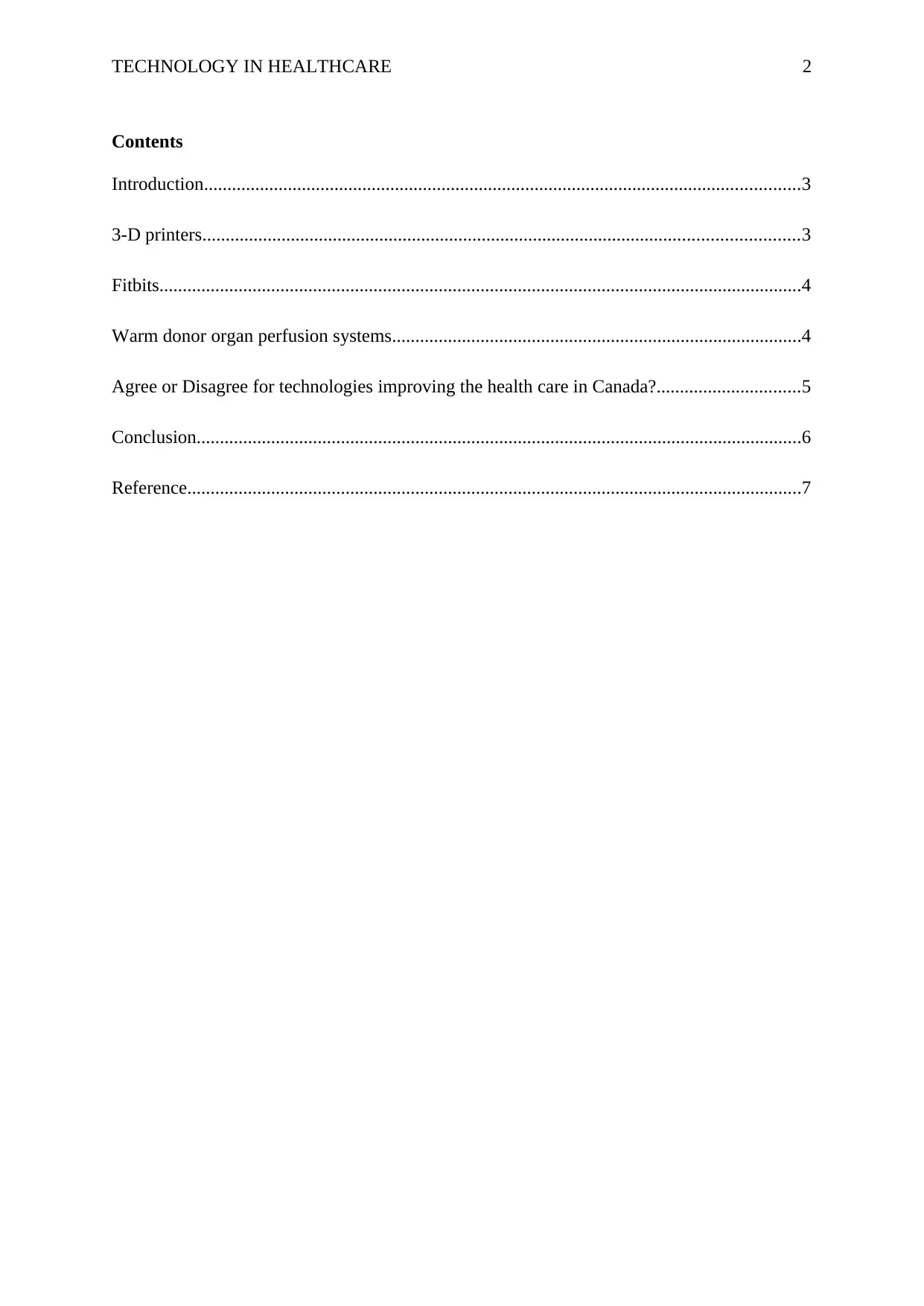
TECHNOLOGY IN HEALTHCARE 2
Contents
Introduction................................................................................................................................3
3-D printers................................................................................................................................3
Fitbits..........................................................................................................................................4
Warm donor organ perfusion systems........................................................................................4
Agree or Disagree for technologies improving the health care in Canada?...............................5
Conclusion..................................................................................................................................6
Reference....................................................................................................................................7
Contents
Introduction................................................................................................................................3
3-D printers................................................................................................................................3
Fitbits..........................................................................................................................................4
Warm donor organ perfusion systems........................................................................................4
Agree or Disagree for technologies improving the health care in Canada?...............................5
Conclusion..................................................................................................................................6
Reference....................................................................................................................................7
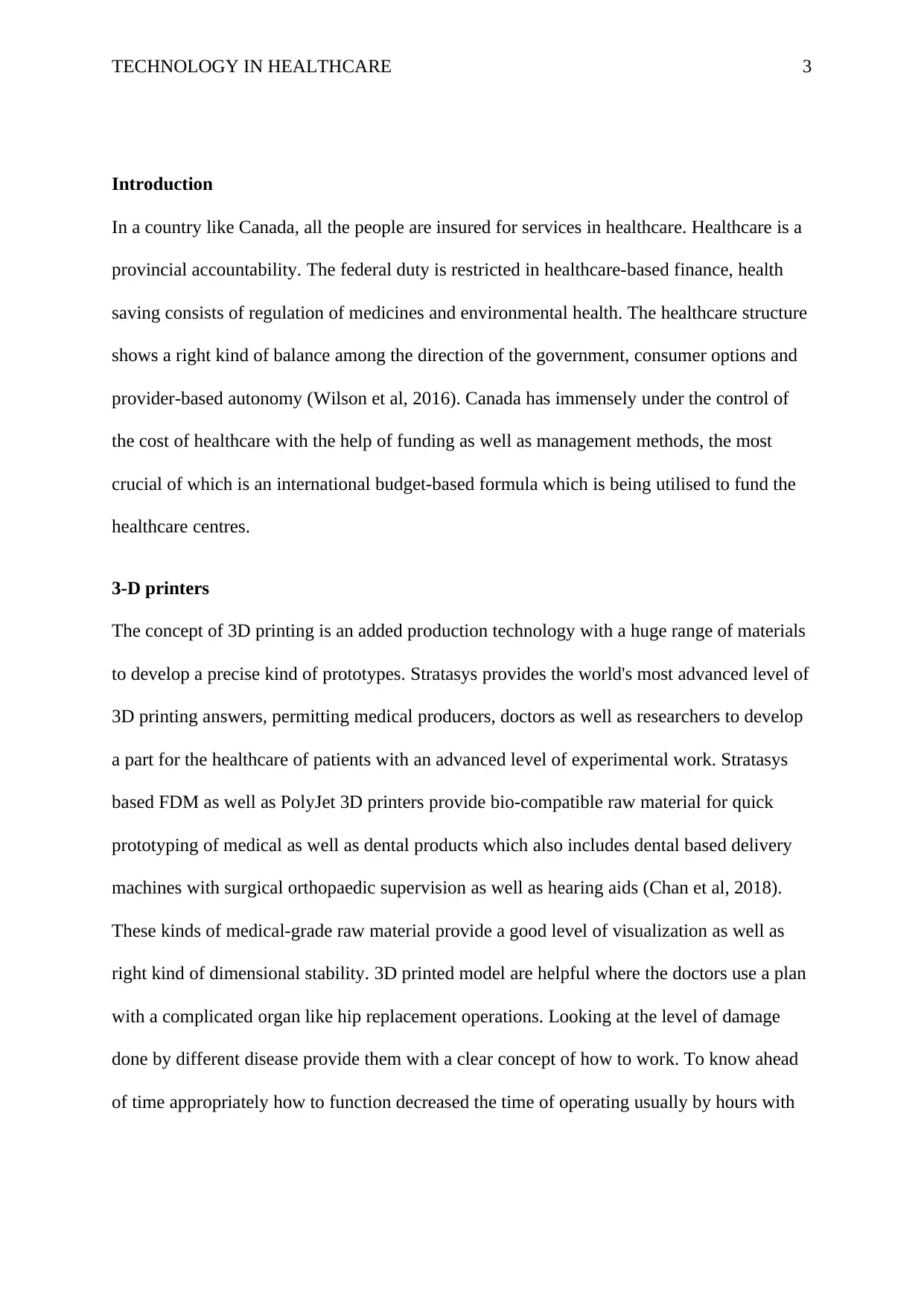
TECHNOLOGY IN HEALTHCARE 3
Introduction
In a country like Canada, all the people are insured for services in healthcare. Healthcare is a
provincial accountability. The federal duty is restricted in healthcare-based finance, health
saving consists of regulation of medicines and environmental health. The healthcare structure
shows a right kind of balance among the direction of the government, consumer options and
provider-based autonomy (Wilson et al, 2016). Canada has immensely under the control of
the cost of healthcare with the help of funding as well as management methods, the most
crucial of which is an international budget-based formula which is being utilised to fund the
healthcare centres.
3-D printers
The concept of 3D printing is an added production technology with a huge range of materials
to develop a precise kind of prototypes. Stratasys provides the world's most advanced level of
3D printing answers, permitting medical producers, doctors as well as researchers to develop
a part for the healthcare of patients with an advanced level of experimental work. Stratasys
based FDM as well as PolyJet 3D printers provide bio-compatible raw material for quick
prototyping of medical as well as dental products which also includes dental based delivery
machines with surgical orthopaedic supervision as well as hearing aids (Chan et al, 2018).
These kinds of medical-grade raw material provide a good level of visualization as well as
right kind of dimensional stability. 3D printed model are helpful where the doctors use a plan
with a complicated organ like hip replacement operations. Looking at the level of damage
done by different disease provide them with a clear concept of how to work. To know ahead
of time appropriately how to function decreased the time of operating usually by hours with
Introduction
In a country like Canada, all the people are insured for services in healthcare. Healthcare is a
provincial accountability. The federal duty is restricted in healthcare-based finance, health
saving consists of regulation of medicines and environmental health. The healthcare structure
shows a right kind of balance among the direction of the government, consumer options and
provider-based autonomy (Wilson et al, 2016). Canada has immensely under the control of
the cost of healthcare with the help of funding as well as management methods, the most
crucial of which is an international budget-based formula which is being utilised to fund the
healthcare centres.
3-D printers
The concept of 3D printing is an added production technology with a huge range of materials
to develop a precise kind of prototypes. Stratasys provides the world's most advanced level of
3D printing answers, permitting medical producers, doctors as well as researchers to develop
a part for the healthcare of patients with an advanced level of experimental work. Stratasys
based FDM as well as PolyJet 3D printers provide bio-compatible raw material for quick
prototyping of medical as well as dental products which also includes dental based delivery
machines with surgical orthopaedic supervision as well as hearing aids (Chan et al, 2018).
These kinds of medical-grade raw material provide a good level of visualization as well as
right kind of dimensional stability. 3D printed model are helpful where the doctors use a plan
with a complicated organ like hip replacement operations. Looking at the level of damage
done by different disease provide them with a clear concept of how to work. To know ahead
of time appropriately how to function decreased the time of operating usually by hours with
⊘ This is a preview!⊘
Do you want full access?
Subscribe today to unlock all pages.

Trusted by 1+ million students worldwide
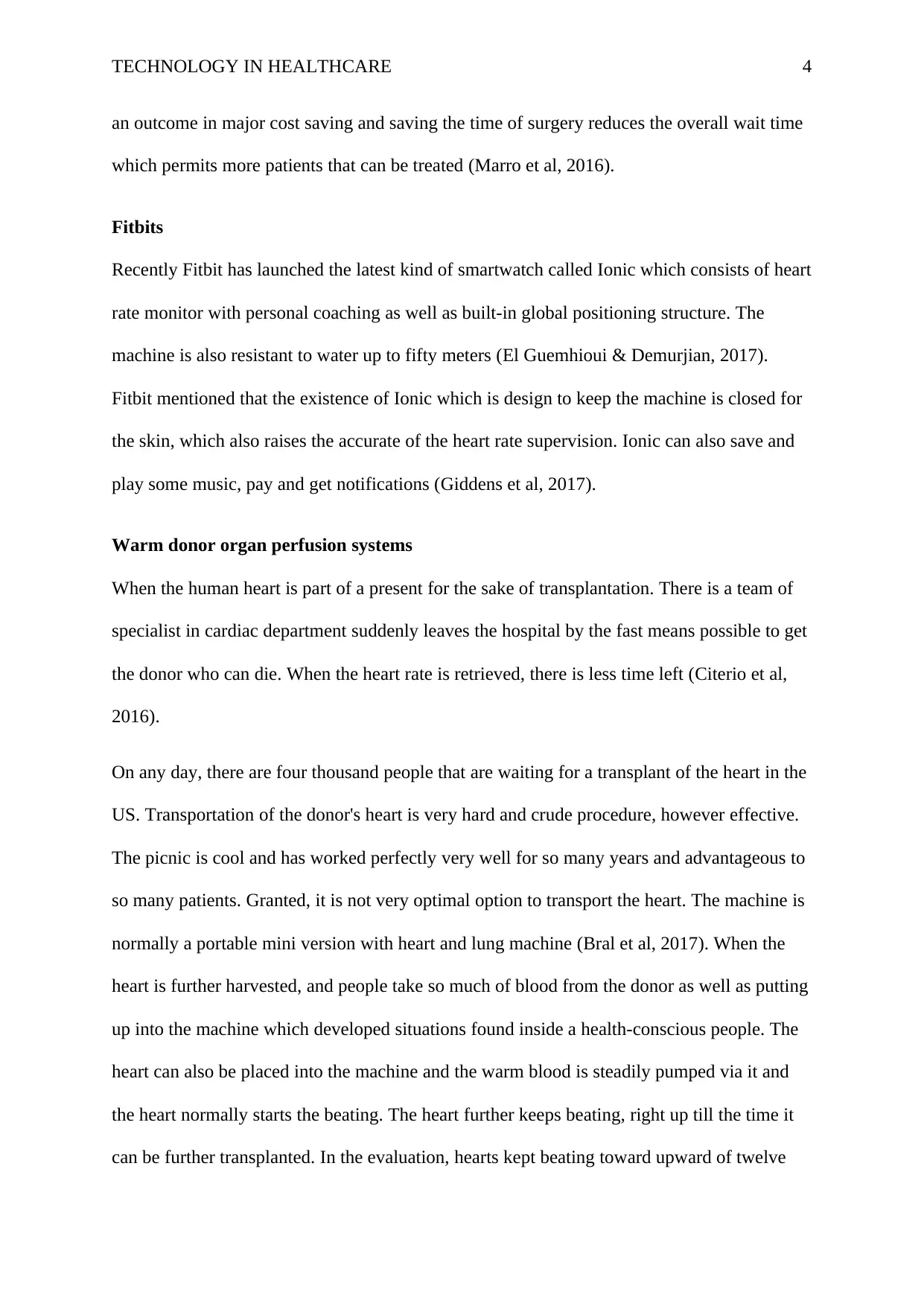
TECHNOLOGY IN HEALTHCARE 4
an outcome in major cost saving and saving the time of surgery reduces the overall wait time
which permits more patients that can be treated (Marro et al, 2016).
Fitbits
Recently Fitbit has launched the latest kind of smartwatch called Ionic which consists of heart
rate monitor with personal coaching as well as built-in global positioning structure. The
machine is also resistant to water up to fifty meters (El Guemhioui & Demurjian, 2017).
Fitbit mentioned that the existence of Ionic which is design to keep the machine is closed for
the skin, which also raises the accurate of the heart rate supervision. Ionic can also save and
play some music, pay and get notifications (Giddens et al, 2017).
Warm donor organ perfusion systems
When the human heart is part of a present for the sake of transplantation. There is a team of
specialist in cardiac department suddenly leaves the hospital by the fast means possible to get
the donor who can die. When the heart rate is retrieved, there is less time left (Citerio et al,
2016).
On any day, there are four thousand people that are waiting for a transplant of the heart in the
US. Transportation of the donor's heart is very hard and crude procedure, however effective.
The picnic is cool and has worked perfectly very well for so many years and advantageous to
so many patients. Granted, it is not very optimal option to transport the heart. The machine is
normally a portable mini version with heart and lung machine (Bral et al, 2017). When the
heart is further harvested, and people take so much of blood from the donor as well as putting
up into the machine which developed situations found inside a health-conscious people. The
heart can also be placed into the machine and the warm blood is steadily pumped via it and
the heart normally starts the beating. The heart further keeps beating, right up till the time it
can be further transplanted. In the evaluation, hearts kept beating toward upward of twelve
an outcome in major cost saving and saving the time of surgery reduces the overall wait time
which permits more patients that can be treated (Marro et al, 2016).
Fitbits
Recently Fitbit has launched the latest kind of smartwatch called Ionic which consists of heart
rate monitor with personal coaching as well as built-in global positioning structure. The
machine is also resistant to water up to fifty meters (El Guemhioui & Demurjian, 2017).
Fitbit mentioned that the existence of Ionic which is design to keep the machine is closed for
the skin, which also raises the accurate of the heart rate supervision. Ionic can also save and
play some music, pay and get notifications (Giddens et al, 2017).
Warm donor organ perfusion systems
When the human heart is part of a present for the sake of transplantation. There is a team of
specialist in cardiac department suddenly leaves the hospital by the fast means possible to get
the donor who can die. When the heart rate is retrieved, there is less time left (Citerio et al,
2016).
On any day, there are four thousand people that are waiting for a transplant of the heart in the
US. Transportation of the donor's heart is very hard and crude procedure, however effective.
The picnic is cool and has worked perfectly very well for so many years and advantageous to
so many patients. Granted, it is not very optimal option to transport the heart. The machine is
normally a portable mini version with heart and lung machine (Bral et al, 2017). When the
heart is further harvested, and people take so much of blood from the donor as well as putting
up into the machine which developed situations found inside a health-conscious people. The
heart can also be placed into the machine and the warm blood is steadily pumped via it and
the heart normally starts the beating. The heart further keeps beating, right up till the time it
can be further transplanted. In the evaluation, hearts kept beating toward upward of twelve
Paraphrase This Document
Need a fresh take? Get an instant paraphrase of this document with our AI Paraphraser
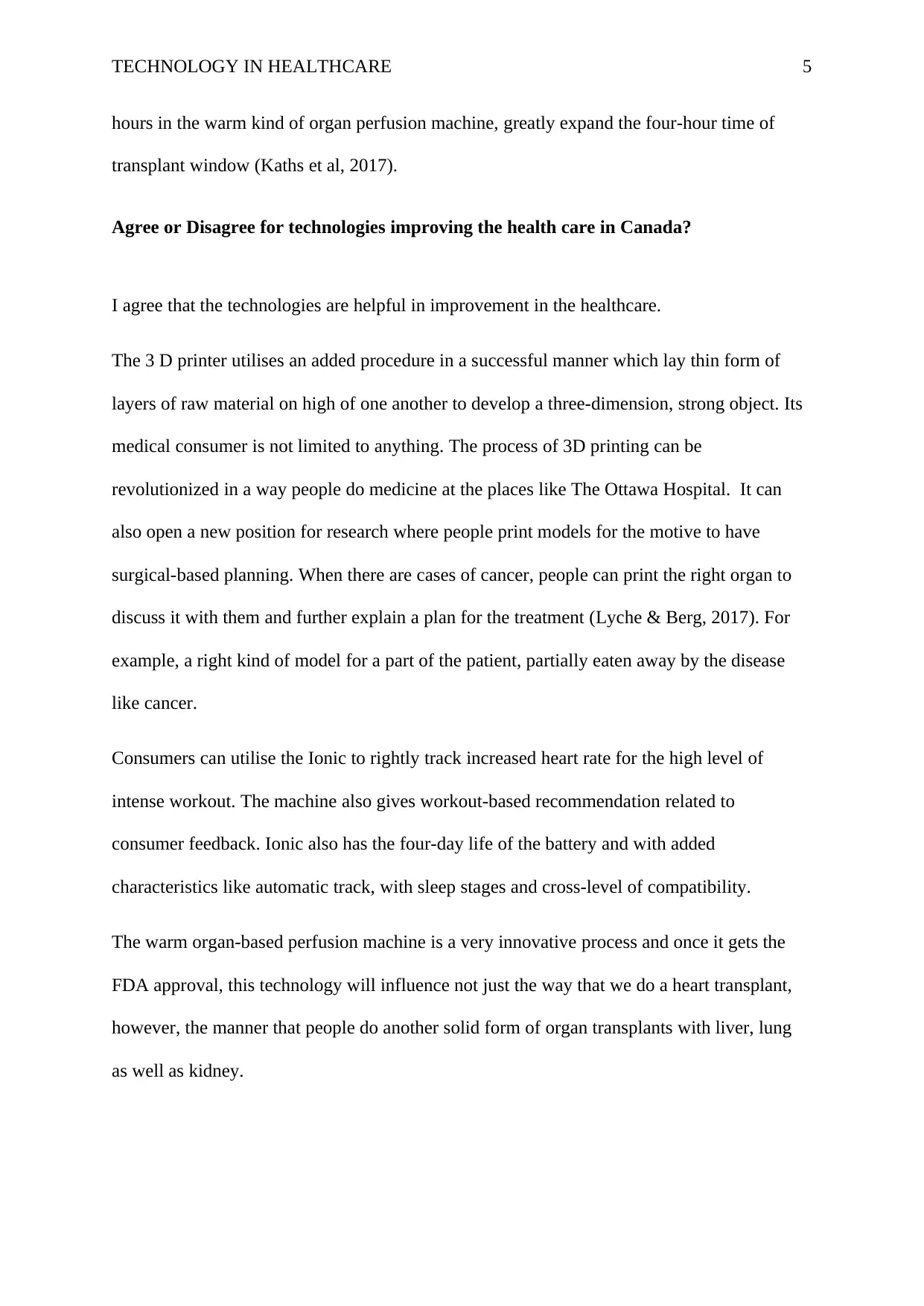
TECHNOLOGY IN HEALTHCARE 5
hours in the warm kind of organ perfusion machine, greatly expand the four-hour time of
transplant window (Kaths et al, 2017).
Agree or Disagree for technologies improving the health care in Canada?
I agree that the technologies are helpful in improvement in the healthcare.
The 3 D printer utilises an added procedure in a successful manner which lay thin form of
layers of raw material on high of one another to develop a three-dimension, strong object. Its
medical consumer is not limited to anything. The process of 3D printing can be
revolutionized in a way people do medicine at the places like The Ottawa Hospital. It can
also open a new position for research where people print models for the motive to have
surgical-based planning. When there are cases of cancer, people can print the right organ to
discuss it with them and further explain a plan for the treatment (Lyche & Berg, 2017). For
example, a right kind of model for a part of the patient, partially eaten away by the disease
like cancer.
Consumers can utilise the Ionic to rightly track increased heart rate for the high level of
intense workout. The machine also gives workout-based recommendation related to
consumer feedback. Ionic also has the four-day life of the battery and with added
characteristics like automatic track, with sleep stages and cross-level of compatibility.
The warm organ-based perfusion machine is a very innovative process and once it gets the
FDA approval, this technology will influence not just the way that we do a heart transplant,
however, the manner that people do another solid form of organ transplants with liver, lung
as well as kidney.
hours in the warm kind of organ perfusion machine, greatly expand the four-hour time of
transplant window (Kaths et al, 2017).
Agree or Disagree for technologies improving the health care in Canada?
I agree that the technologies are helpful in improvement in the healthcare.
The 3 D printer utilises an added procedure in a successful manner which lay thin form of
layers of raw material on high of one another to develop a three-dimension, strong object. Its
medical consumer is not limited to anything. The process of 3D printing can be
revolutionized in a way people do medicine at the places like The Ottawa Hospital. It can
also open a new position for research where people print models for the motive to have
surgical-based planning. When there are cases of cancer, people can print the right organ to
discuss it with them and further explain a plan for the treatment (Lyche & Berg, 2017). For
example, a right kind of model for a part of the patient, partially eaten away by the disease
like cancer.
Consumers can utilise the Ionic to rightly track increased heart rate for the high level of
intense workout. The machine also gives workout-based recommendation related to
consumer feedback. Ionic also has the four-day life of the battery and with added
characteristics like automatic track, with sleep stages and cross-level of compatibility.
The warm organ-based perfusion machine is a very innovative process and once it gets the
FDA approval, this technology will influence not just the way that we do a heart transplant,
however, the manner that people do another solid form of organ transplants with liver, lung
as well as kidney.
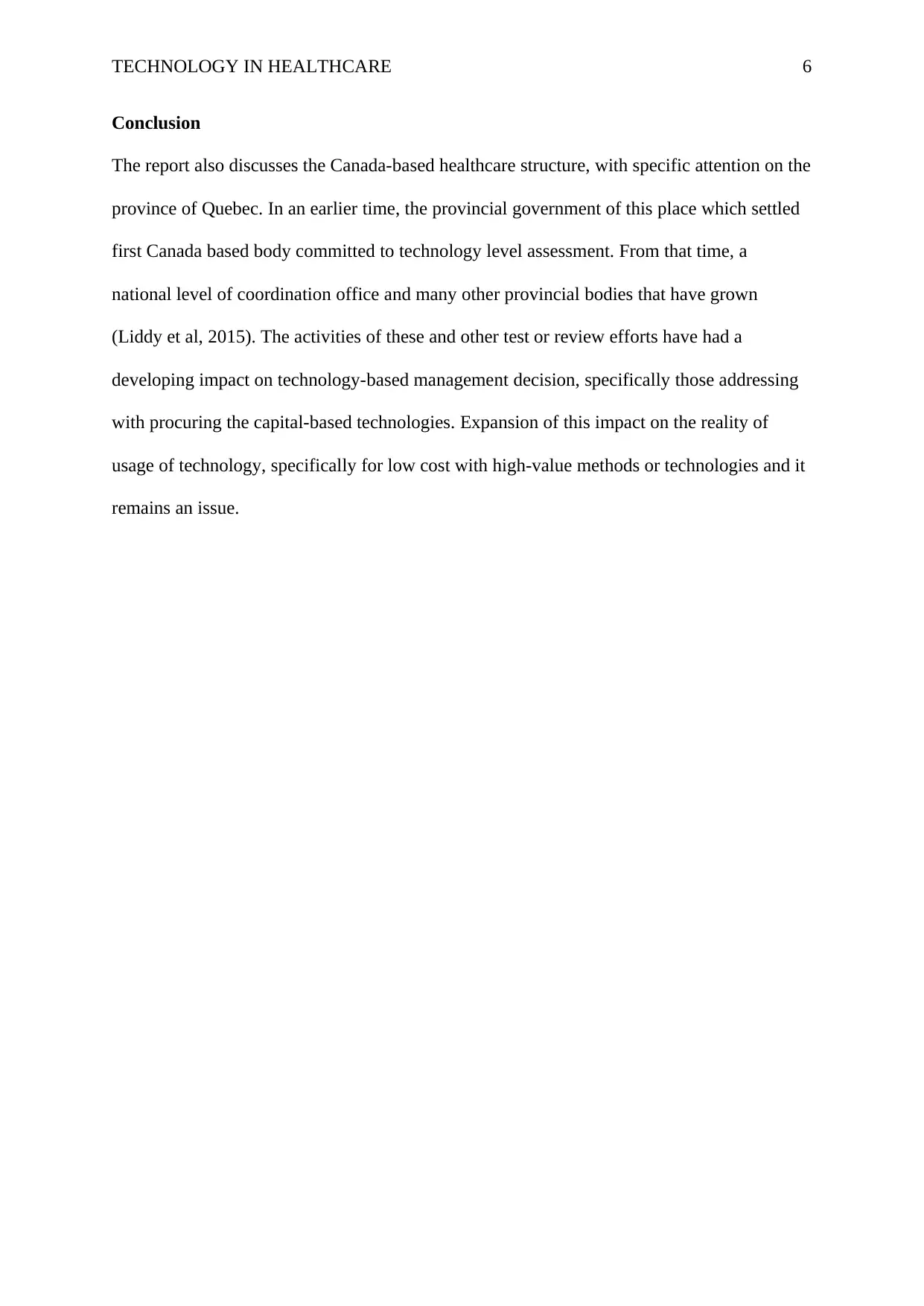
TECHNOLOGY IN HEALTHCARE 6
Conclusion
The report also discusses the Canada-based healthcare structure, with specific attention on the
province of Quebec. In an earlier time, the provincial government of this place which settled
first Canada based body committed to technology level assessment. From that time, a
national level of coordination office and many other provincial bodies that have grown
(Liddy et al, 2015). The activities of these and other test or review efforts have had a
developing impact on technology-based management decision, specifically those addressing
with procuring the capital-based technologies. Expansion of this impact on the reality of
usage of technology, specifically for low cost with high-value methods or technologies and it
remains an issue.
Conclusion
The report also discusses the Canada-based healthcare structure, with specific attention on the
province of Quebec. In an earlier time, the provincial government of this place which settled
first Canada based body committed to technology level assessment. From that time, a
national level of coordination office and many other provincial bodies that have grown
(Liddy et al, 2015). The activities of these and other test or review efforts have had a
developing impact on technology-based management decision, specifically those addressing
with procuring the capital-based technologies. Expansion of this impact on the reality of
usage of technology, specifically for low cost with high-value methods or technologies and it
remains an issue.
⊘ This is a preview!⊘
Do you want full access?
Subscribe today to unlock all pages.

Trusted by 1+ million students worldwide
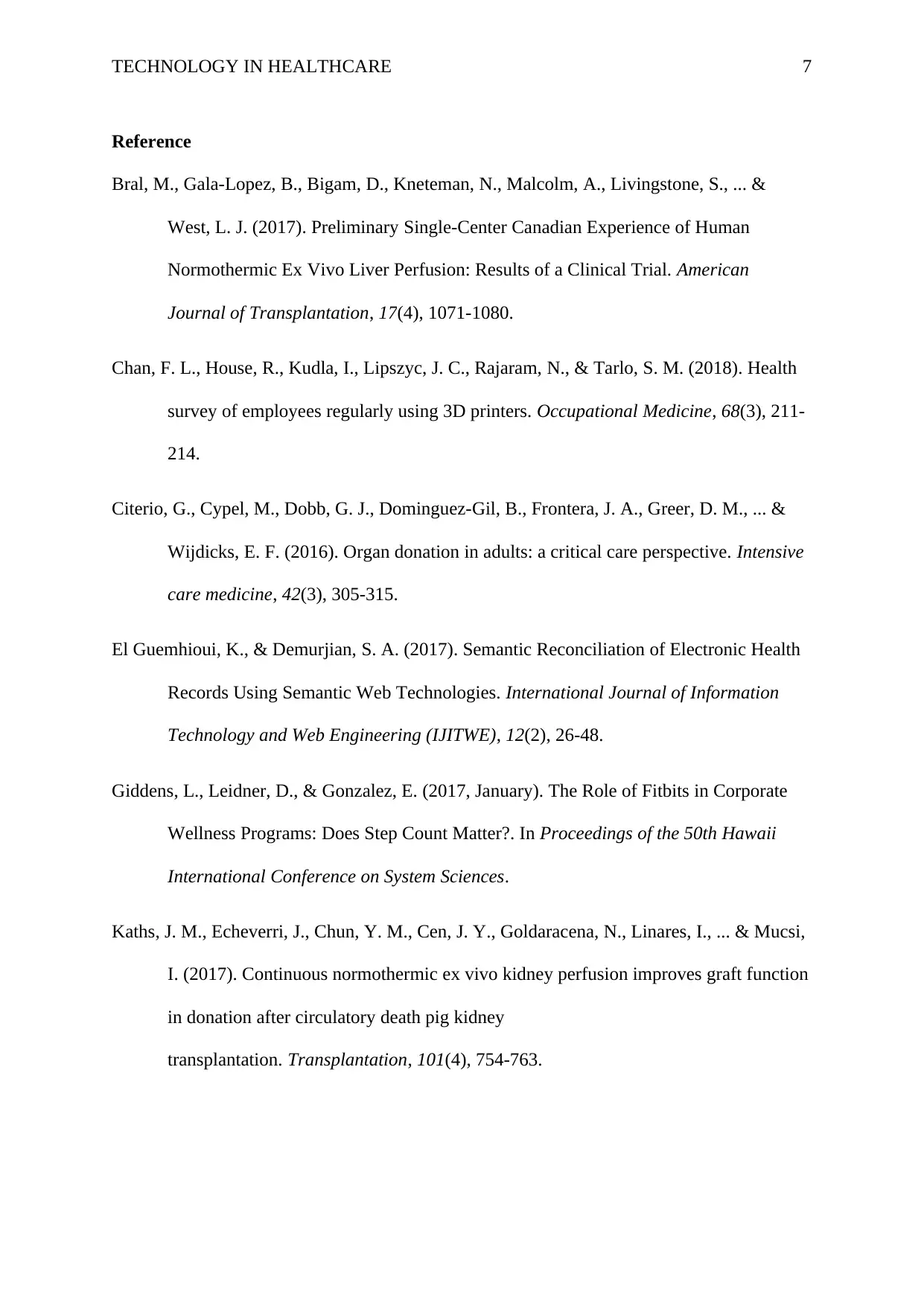
TECHNOLOGY IN HEALTHCARE 7
Reference
Bral, M., Gala‐Lopez, B., Bigam, D., Kneteman, N., Malcolm, A., Livingstone, S., ... &
West, L. J. (2017). Preliminary Single‐Center Canadian Experience of Human
Normothermic Ex Vivo Liver Perfusion: Results of a Clinical Trial. American
Journal of Transplantation, 17(4), 1071-1080.
Chan, F. L., House, R., Kudla, I., Lipszyc, J. C., Rajaram, N., & Tarlo, S. M. (2018). Health
survey of employees regularly using 3D printers. Occupational Medicine, 68(3), 211-
214.
Citerio, G., Cypel, M., Dobb, G. J., Dominguez-Gil, B., Frontera, J. A., Greer, D. M., ... &
Wijdicks, E. F. (2016). Organ donation in adults: a critical care perspective. Intensive
care medicine, 42(3), 305-315.
El Guemhioui, K., & Demurjian, S. A. (2017). Semantic Reconciliation of Electronic Health
Records Using Semantic Web Technologies. International Journal of Information
Technology and Web Engineering (IJITWE), 12(2), 26-48.
Giddens, L., Leidner, D., & Gonzalez, E. (2017, January). The Role of Fitbits in Corporate
Wellness Programs: Does Step Count Matter?. In Proceedings of the 50th Hawaii
International Conference on System Sciences.
Kaths, J. M., Echeverri, J., Chun, Y. M., Cen, J. Y., Goldaracena, N., Linares, I., ... & Mucsi,
I. (2017). Continuous normothermic ex vivo kidney perfusion improves graft function
in donation after circulatory death pig kidney
transplantation. Transplantation, 101(4), 754-763.
Reference
Bral, M., Gala‐Lopez, B., Bigam, D., Kneteman, N., Malcolm, A., Livingstone, S., ... &
West, L. J. (2017). Preliminary Single‐Center Canadian Experience of Human
Normothermic Ex Vivo Liver Perfusion: Results of a Clinical Trial. American
Journal of Transplantation, 17(4), 1071-1080.
Chan, F. L., House, R., Kudla, I., Lipszyc, J. C., Rajaram, N., & Tarlo, S. M. (2018). Health
survey of employees regularly using 3D printers. Occupational Medicine, 68(3), 211-
214.
Citerio, G., Cypel, M., Dobb, G. J., Dominguez-Gil, B., Frontera, J. A., Greer, D. M., ... &
Wijdicks, E. F. (2016). Organ donation in adults: a critical care perspective. Intensive
care medicine, 42(3), 305-315.
El Guemhioui, K., & Demurjian, S. A. (2017). Semantic Reconciliation of Electronic Health
Records Using Semantic Web Technologies. International Journal of Information
Technology and Web Engineering (IJITWE), 12(2), 26-48.
Giddens, L., Leidner, D., & Gonzalez, E. (2017, January). The Role of Fitbits in Corporate
Wellness Programs: Does Step Count Matter?. In Proceedings of the 50th Hawaii
International Conference on System Sciences.
Kaths, J. M., Echeverri, J., Chun, Y. M., Cen, J. Y., Goldaracena, N., Linares, I., ... & Mucsi,
I. (2017). Continuous normothermic ex vivo kidney perfusion improves graft function
in donation after circulatory death pig kidney
transplantation. Transplantation, 101(4), 754-763.
Paraphrase This Document
Need a fresh take? Get an instant paraphrase of this document with our AI Paraphraser
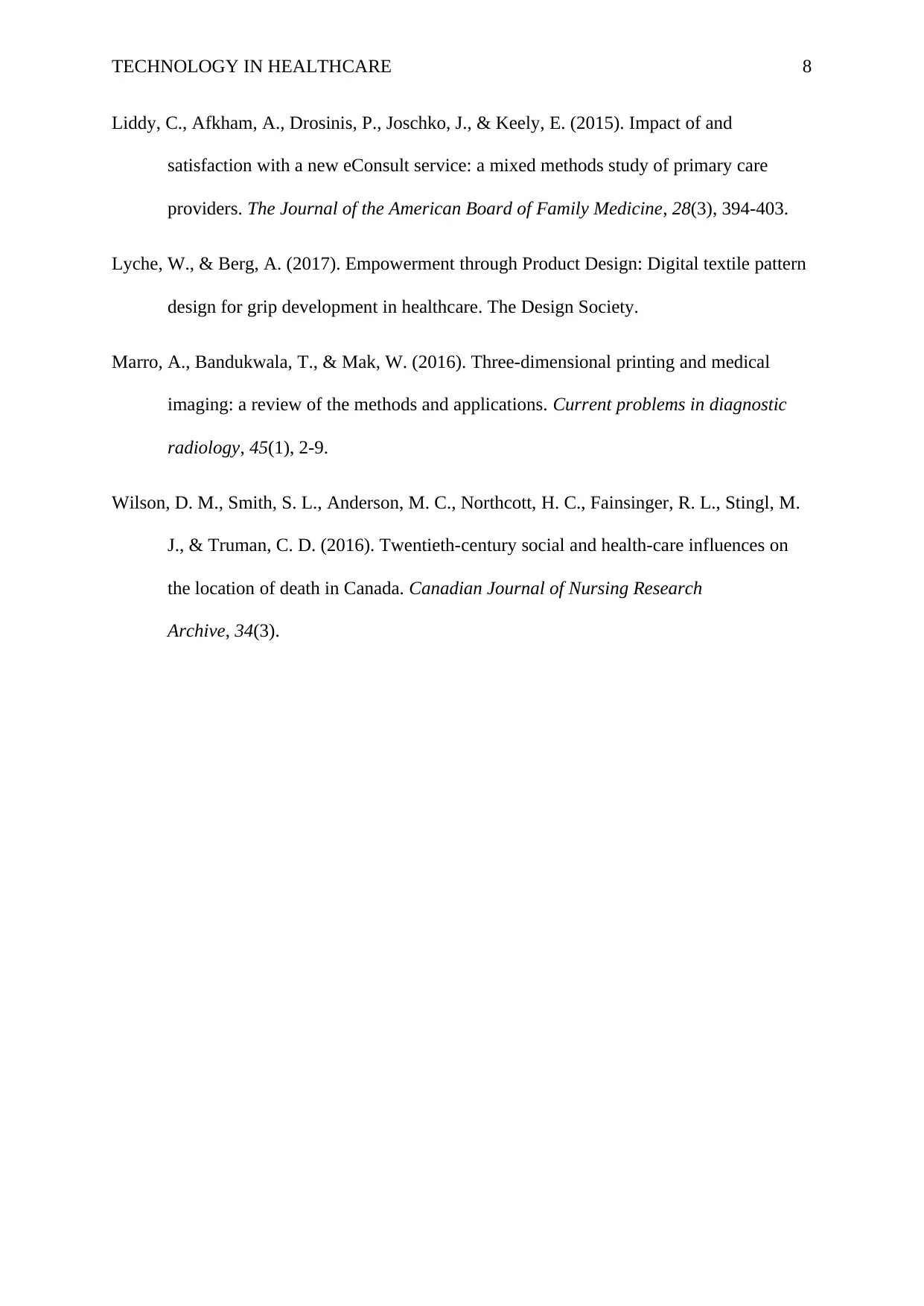
TECHNOLOGY IN HEALTHCARE 8
Liddy, C., Afkham, A., Drosinis, P., Joschko, J., & Keely, E. (2015). Impact of and
satisfaction with a new eConsult service: a mixed methods study of primary care
providers. The Journal of the American Board of Family Medicine, 28(3), 394-403.
Lyche, W., & Berg, A. (2017). Empowerment through Product Design: Digital textile pattern
design for grip development in healthcare. The Design Society.
Marro, A., Bandukwala, T., & Mak, W. (2016). Three-dimensional printing and medical
imaging: a review of the methods and applications. Current problems in diagnostic
radiology, 45(1), 2-9.
Wilson, D. M., Smith, S. L., Anderson, M. C., Northcott, H. C., Fainsinger, R. L., Stingl, M.
J., & Truman, C. D. (2016). Twentieth-century social and health-care influences on
the location of death in Canada. Canadian Journal of Nursing Research
Archive, 34(3).
Liddy, C., Afkham, A., Drosinis, P., Joschko, J., & Keely, E. (2015). Impact of and
satisfaction with a new eConsult service: a mixed methods study of primary care
providers. The Journal of the American Board of Family Medicine, 28(3), 394-403.
Lyche, W., & Berg, A. (2017). Empowerment through Product Design: Digital textile pattern
design for grip development in healthcare. The Design Society.
Marro, A., Bandukwala, T., & Mak, W. (2016). Three-dimensional printing and medical
imaging: a review of the methods and applications. Current problems in diagnostic
radiology, 45(1), 2-9.
Wilson, D. M., Smith, S. L., Anderson, M. C., Northcott, H. C., Fainsinger, R. L., Stingl, M.
J., & Truman, C. D. (2016). Twentieth-century social and health-care influences on
the location of death in Canada. Canadian Journal of Nursing Research
Archive, 34(3).
1 out of 8
Your All-in-One AI-Powered Toolkit for Academic Success.
+13062052269
info@desklib.com
Available 24*7 on WhatsApp / Email
![[object Object]](/_next/static/media/star-bottom.7253800d.svg)
Unlock your academic potential
Copyright © 2020–2025 A2Z Services. All Rights Reserved. Developed and managed by ZUCOL.